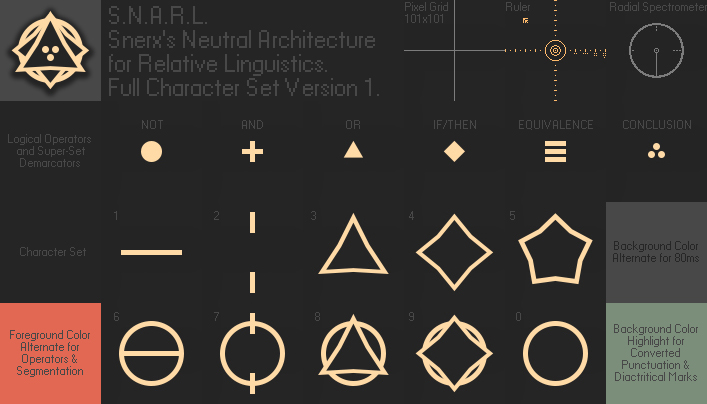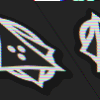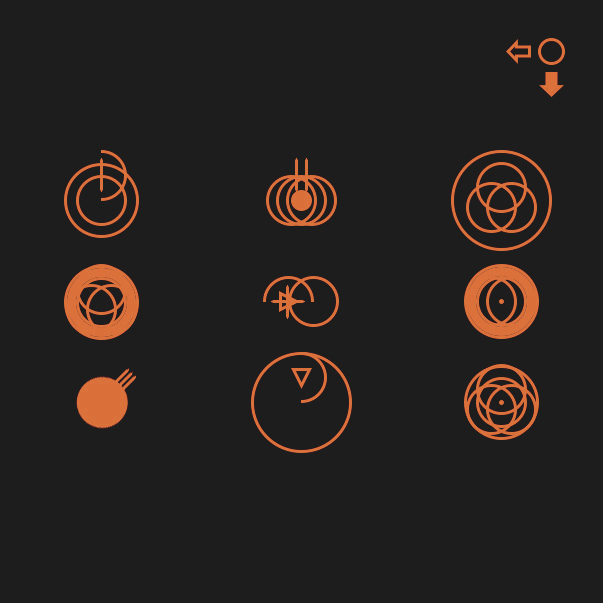Home • Version 0.0.9 • Last Updated 2022/12/6 • Read Time 6min • Discord ______________________________________________________________________________________ :: Snerx's Neutral Architecture for Relative Linguistics ::
Snarl was a semiotic research project and universal-bridge-language framework built off SnorkShown at the bottom of this page. that aimed to find the most effective use of symbolic implementation for data communication over typical mediums, scalable and transferable between species and modes of communication by allowing for a 'formatless' framework and relative character set. This could potentially have let Snarl function as a quasi-universal lingua franca. Snarl has been discontinued in pursuit of better semiotic frameworks. Snarl has no advanced formatting, no read direction, and no diacritical markings or punctuation marks. This reduction of complexity allows for Snarl to be read and understood with immediacy, a full comprehension of a large text at just a glance. It maintains the same density of information as traditional languages despite its lack of traditional structuring due to "point-threaded flow formatting" where characters and words are single-instance objects in a textual space, being projected over each other in a continuous stream or 'flow'. Background and foreground color coding is used for any additional grammar or information needed for conversion of a language into Snarl. The characters themselves are modeled around common natural and mathematical shapes, making them easily recognized and cognized by any species processing the information. The symbols used for the characters are ordered based on the number of objects or points that the symbol characterizes (which correlates to their numerical values as explained later). All characters are fixated around a central point of rotation with all proportions being equal, so characters also have unit circle values. The alphabet contains only five base characters with five additional layered characters for an alphabet of ten characters total. Since letters also double as numbers in Snarl, Snarl is a base-10 language. This can be dynamically changed and scaled within the framework to be relative to the math base that the society utilizing it is more accustomed to. On top of all that, Snarl is an a priori language with six base operators that also function as super-set demarcators, so logical operations are native to the language and the alphabet has six super-sets, meaning the language has an extensible character set of seventy characters and can convert programming languages as well. The slow-stream 'glance' version of the Snarl framework (pictured below) runs at 250ms intervals. In this mode the characters rotate 5 degrees clockwise for their first interval, then reverse rotation 2 degrees on their second interval and fade outwards to leave a visual imprint for the human brain to catch. This allows you to read multiple symbols simultaneously.[250msHelloWorld.gif]The fast 'flash' version of the language runs at 83ms, close to the average speed for human cognition of experience. No rotations or overlay fades in this version, as that is extra information that gets in the way of processing visual data. Background colors may alternate shades in this version to help with visual pacing for the human brain. This is close to the fastest possible speed humans can cognize visual experience, the fastest possible speed that humans can read, so this semiotic arrangement should give way to the most efficient textual architecture possible in principle.
The slow-stream 'glance' version of the Snarl framework (pictured below) runs at 250ms intervals. In this mode the characters rotate 5 degrees clockwise for their first interval, then reverse rotation 2 degrees on their second interval and fade outwards to leave a visual imprint for the human brain to catch. This allows you to read multiple symbols simultaneously.[250msHelloWorld.gif]The fast 'flash' version of the language runs at 83ms, close to the average speed for human cognition of experience. No rotations or overlay fades in this version, as that is extra information that gets in the way of processing visual data. Background colors may alternate shades in this version to help with visual pacing for the human brain. This is close to the fastest possible speed humans can cognize visual experience, the fastest possible speed that humans can read, so this semiotic arrangement should give way to the most efficient textual architecture possible in principle.
 Radial audio spectrometer integration will make it so each symbol has a definite, objective sound tied to it, meaning that recording audio of someone speaking the language will produce the Snarl symbols they represent in a radial audio spectrometer. This will also mean that writing the language will be equivalent to speaking it and hearing it will be the same as reading it, almost like synesthesia. Snarl is the first language to ever do this. Some image based spectrometer like Photosounder or Spiral will allow for this first point-threaded language format, whereby you read by watching a dynamic animation or image of sound being produced in real-time, rather than static or fixed words. I imagine you could use something similar to generate symbols from any spoken language or acoustic communication system. This project is otherwise dead unless linguists or conlangers want to revive it, otherwise it would be more valuable to check out the work I've done on /semiotics.:: SNORK ::Snork was an a-priori language framework based on the unit circle whose formatting orientation allowed it to be read from any direction. It made bridging aesthetic languages easier and created an objective mathematical basis (constant and average numerical values) for all languages converted. It was also a potential way to have a universal primary a-priori bridge language, a lingua franca, due to its format morphing and multifunction uses. Snork served as the basis for the Snarl project. I am completely open to edits and revisions of the language rules and base character design but the project has been otherwise abandoned. All the character design was based on common naturally and mathematically occurring shapes found in our universe, so they would be more easily recognized by any non-human species that analyzed them. The characters' orientation about their local origins was based on common radian angle measurements starting from 1/2 pi and rotating by increments of 1/4 pi (45 degree rotations). This meant every compound character would have a definite trigonometric value (unless undefined). Averaging out all the sine values of every word translated from English compared to every word translated from Japanese would provide interesting, if not useful, information about the languages. Speaking of English to Japanese, the read-directions and orientation of the characters in Snork are dynamic. It can be read from left to right, right to left, top to bottom, or bottom to top. There is an orientation symbol used to distinguish which direction is the primary direction to read from and which direction is secondary. This makes formatting more trivial and easier to manipulate. I had thought about removing the definite North-South orientation and eliminating the radian measures altogether so the language could be read upsidown and backwards, making formatting much more trivial and allowing for an even more universal understanding of the language, but I had already moved on to Snarl by then. There are no spaces or punctuation insertions that break character flow. Instead, grammatical formatting hangs off the top & bottom, or left & right sides of the character flow. A couple pictures of all this are posted below. This was a useful linguistic/semiotic research tool. This framework was a means by which to create a written language that was not merely objective in its ties to mathematics, but objective in all its assertions, as it was to be integrated with one of my other projects in formal logic, but better things exist now. The original project outline for Snork was poorly ideated and posted here.
Radial audio spectrometer integration will make it so each symbol has a definite, objective sound tied to it, meaning that recording audio of someone speaking the language will produce the Snarl symbols they represent in a radial audio spectrometer. This will also mean that writing the language will be equivalent to speaking it and hearing it will be the same as reading it, almost like synesthesia. Snarl is the first language to ever do this. Some image based spectrometer like Photosounder or Spiral will allow for this first point-threaded language format, whereby you read by watching a dynamic animation or image of sound being produced in real-time, rather than static or fixed words. I imagine you could use something similar to generate symbols from any spoken language or acoustic communication system. This project is otherwise dead unless linguists or conlangers want to revive it, otherwise it would be more valuable to check out the work I've done on /semiotics.:: SNORK ::Snork was an a-priori language framework based on the unit circle whose formatting orientation allowed it to be read from any direction. It made bridging aesthetic languages easier and created an objective mathematical basis (constant and average numerical values) for all languages converted. It was also a potential way to have a universal primary a-priori bridge language, a lingua franca, due to its format morphing and multifunction uses. Snork served as the basis for the Snarl project. I am completely open to edits and revisions of the language rules and base character design but the project has been otherwise abandoned. All the character design was based on common naturally and mathematically occurring shapes found in our universe, so they would be more easily recognized by any non-human species that analyzed them. The characters' orientation about their local origins was based on common radian angle measurements starting from 1/2 pi and rotating by increments of 1/4 pi (45 degree rotations). This meant every compound character would have a definite trigonometric value (unless undefined). Averaging out all the sine values of every word translated from English compared to every word translated from Japanese would provide interesting, if not useful, information about the languages. Speaking of English to Japanese, the read-directions and orientation of the characters in Snork are dynamic. It can be read from left to right, right to left, top to bottom, or bottom to top. There is an orientation symbol used to distinguish which direction is the primary direction to read from and which direction is secondary. This makes formatting more trivial and easier to manipulate. I had thought about removing the definite North-South orientation and eliminating the radian measures altogether so the language could be read upsidown and backwards, making formatting much more trivial and allowing for an even more universal understanding of the language, but I had already moved on to Snarl by then. There are no spaces or punctuation insertions that break character flow. Instead, grammatical formatting hangs off the top & bottom, or left & right sides of the character flow. A couple pictures of all this are posted below. This was a useful linguistic/semiotic research tool. This framework was a means by which to create a written language that was not merely objective in its ties to mathematics, but objective in all its assertions, as it was to be integrated with one of my other projects in formal logic, but better things exist now. The original project outline for Snork was poorly ideated and posted here.The same text can be read the way shown below as well.
